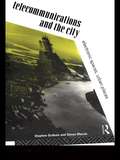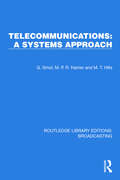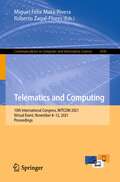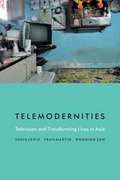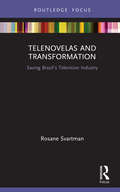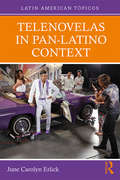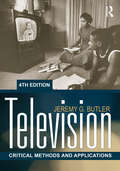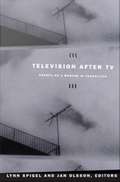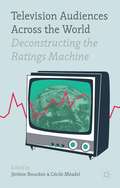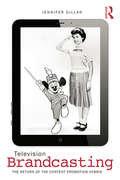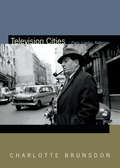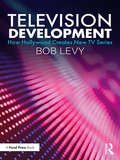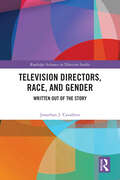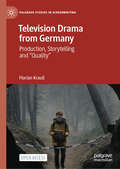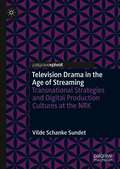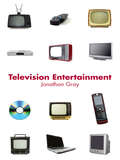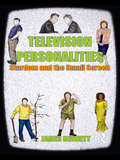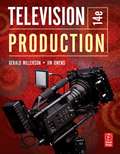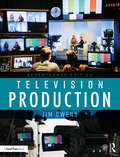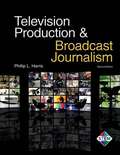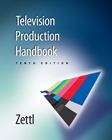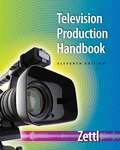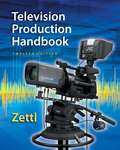- Table View
- List View
Telecommunications and the City: Electronic Spaces, Urban Places
by Steve Graham Simon MarvinTelecommunications and the City provides the first critical and state-of-the-art review of the relations between telecommunications and all aspects of city development and management.Drawing on a range of theoretical approaches and a wide body of recent research, the book addresses key academic and policy debates about technological change and the future of cities with a fresh perspective. Through this approach, the complex and crucial transformations underway in cities in which telecommunications have central importance are mapped out and illustrated. Key areas where telecommunications impinge on the economic, social, physical, enviromental and institutional development of cities are illustrated by using boxed extracts and wide range of case study examples from Europe, Japan and North America.Rejecting the extremes of optimism and pessimism in current hype about cities and telecommunications, Telecommunications and the City offers a sophisticated new perspective through which city-telecommunications relations can be understood.
Telecommunications in Developing Countries: The Challenge from Brazil (Routledge Library Editions: Broadcasting #34)
by Michael HobdayTelecommunications in Developing Countries (1990) stresses the importance of modern, micro electronics-based telecommunications for developing economies in providing a basic communications infrastructure for economic and industrial development and the springboard for new information technology activities. Although progress in telecommunications has so far been concentrated in the most advanced regions of the world, some developing countries can bypass older, less efficient forms of telecommunications and go straight to microelectronic technology. This book is the first to examine the challenges and difficulties facing developing countries in this field. extending existing theories of technology transfer and diffusion, Michael Hobday offers an explanation of the forces for change in the telecommunications industry. He then examines Brazil's experience in telecommunications, from developing the technology and building up a modern infrastructure to controlling multinational suppliers of equipment. Dr Hobday explains why Brazil's efforts in this area have succeeded, and offers lessons for other developing countries.
Telecommunications: A Systems Approach (Routledge Library Editions: Broadcasting #33)
by G. Smol M.P.R. Hamer M.T. HillsTelecommunications: A Systems Approach (1976) uses two extended case studies, of public telephone and television systems, in order to introduce the basic ideas of telecommunication systems. It describes the application of a number of techniques within the context of practical telecommunications systems, and takes into account the needs of the users of these systems and the economic constraints which affect the choice of techniques and the overall system structure.
Telematics and Computing: 10th International Congress, WITCOM 2021, Virtual Event, November 8–12, 2021, Proceedings (Communications in Computer and Information Science #1430)
by Roberto Zagal-Flores Miguel Félix Mata-RiveraThis book constitutes the thoroughly refereed proceedings of the 10th International Congress on Telematics and Computing, WITCOM 2021, held in November 2021. Due to the COVID-19 pandemic the conference was held online. The 12 full papers and 7 short papers in this volume were carefully reviewed and selected from 48 submissions. The papers are focused on the topics of deep and machine learning, cybersecurity, wireless networks, computer vision, communications, and education applied to different sceneries of study and COVID-19.
Telemodernities: Television and Transforming Lives in Asia
by Fran Martin Wanning Sun Tania LewisYoga gurus on lifestyle cable channels targeting time-pressured Indian urbanites; Chinese dating shows promoting competitive individualism; Taiwanese domestic makeover formats combining feng shui with life planning advice: Asian TV screens are increasingly home to a wild proliferation of popular factual programs providing lifestyle guidance to viewers. In Telemodernities Tania Lewis, Fran Martin, and Wanning Sun demonstrate how lifestyle-oriented popular factual television illuminates key aspects of late modernities in South and East Asia, offering insights not only into early twenty-first-century media cultures but also into wider developments in the nature of public and private life, identity, citizenship, and social engagement. Drawing on extensive interviews with television industry professionals and audiences across China, India, Taiwan, and Singapore, Telemodernities uses popular lifestyle television as a tool to help us understand emergent forms of identity, sociality, and capitalist modernity in Asia.
Telenovelas and Transformation: Saving Brazil’s Television Industry (Routledge Advances in Transmedia Studies)
by Rosane SvartmanThis book investigates how telenovelas may be the key to the future of Brazilian television and how this content can survive in an interconnected media landscape. Recognised telenovela writer and scholar Rosane Svartman considers the particular characteristics of the telenovela format – number of episodes, melodrama influence, and influence of the audience on future writing – to explore how these can be preserved on multimedia platforms, and the challenges this change may present. Svartman further charts the transformations of the telenovela throughout its history and its major influences and unveils the main storytelling elements and writing processes. Chapters examine the business model of Brazilian corporate television within the current context of hypermedia and analyse how this relationship evolves as it is influenced by the new interactive tools and technologies that amplify the audience’s power. Merging empirical practices and theory, this book will be of great interest to scholars and students of transmedia storytelling, television studies, and Latin American media, as well as professionals working in these areas.
Telenovelas in Pan-Latino Context (Latin American Tópicos)
by June Carolyn ErlickThis concise book provides an accessible overview of the history of the telenovela in Latin America within a pan-Latino context, including the way the genre crosses borders between Latin America and the United States. Telenovelas, a distinct variety of soap operas originating in Latin America, take up key issues of race, class, sexual identity and violence, interweaving stories with melodramatic romance and quests for identity. June Carolyn Erlick examines the social implications of telenovela themes in the context of the evolution of television as an integral part of the modernization of Latin American countries.
Television
by Jeremy G. ButlerFor nearly two decades, Television: Critical Methods and Applications has served as the foremost guide to television studies. Designed for the television studies course in communication and media studies curricula, Television explains in depth how television programs and commercials are made and how they function as producers of meaning. Author Jeremy G. Butler shows the ways in which camera style, lighting, set design, editing, and sound combine to produce meanings that viewers take away from their television experience. He supplies students with a whole toolbox of implements to disassemble television and read between the lines, teaching them to incorporate critical thinking into their own television viewing. The fourth edition builds upon the pedagogy of previous editions to best accommodate current modes of understanding and teaching television. Highlights of the fourth edition include: New chapter and part organization to reflect the current approach to teaching television--with greatly expanded methods and theories chapters. An entirely new chapter on modes of production and their impact on what you see on the screen. Discussions integrated throughout on the latest developments in television's on-going convergence with other media, such as material on transmedia storytelling and YouTube's impact on video distribution. Over three hundred printed illustrations, including new and better quality frame grabs of recent television shows and commercials. A companion website featuring color frame grabs, a glossary, flash cards, and editing and sound exercises for students, as well as PowerPoint presentations, sample syllabi and other materials for instructors. Links to online videos that support examples in the text are also provided. With its distinctive approach to examining television, Television is appropriate for courses in television studies, media criticism, and general critical studies.
Television After TV: Essays on a Medium in Transition
by Lynn Spigel Jan OlssonIn the last ten years, television has reinvented itself in numerous ways. The demise of the U. S. three-network system, the rise of multi-channel cable and global satellite delivery, changes in regulation policies and ownership rules, technological innovations in screen design, and the development of digital systems like TiVo have combined to transform the practice we call watching tv. If tv refers to the technologies, program forms, government policies, and practices of looking associated with the medium in its classic public service and three-network age, it appears that we are now entering a new phase of television. Exploring these changes, the essays in this collection consider the future of television in the United States and Europe and the scholarship and activism focused on it. With historical, critical, and speculative essays by some of the leading television and media scholars, Television after TV examines both commercial and public service traditions and evaluates their dual (and some say merging) fates in our global, digital culture of convergence. The essays explore a broad range of topics, including contemporary programming and advertising strategies, the use of television and the Internet among diasporic and minority populations, the innovations of new technologies like TiVo, the rise of program forms from reality tv to lifestyle programs, television's changing role in public places and at home, the Internet's use as a means of social activism, and television's role in education and the arts. In dialogue with previous media theorists and historians, the contributors collectively rethink the goals of media scholarship, pointing toward new ways of accounting for television's past, present, and future. Contributors William Boddy Charlotte Brunsdon John T. Caldwell Michael Curtin Julie D'Acci Anna Everett Jostein Gripsrud John Hartley Anna McCarthy David Morley Jan Olsson Priscilla Pea Ovalle Lisa Parks Jeffrey Sconce Lynn Spigel William Uricchio
Television Audiences Across the World: Deconstructing the Ratings Machine
by Cécile Méadel Jérôme BourdonThis book is the first to deal with the world composition of television ratings. It focuses on the peoplemeter, a 25 year old technology which succeeds in homogenizing very different populations and television practices. It provides a fascinating account of the production of figures on which the whole world of popular culture depends.
Television Brandcasting: The Return of the Content-Promotion Hybrid
by Jennifer GillanTelevision Brandcasting examines U. S. television’s utility as a medium for branded storytelling. It investigates the current and historical role that television content, promotion, and hybrids of the two have played in disseminating brand messaging and influencing consumer decision-making. Juxtaposing the current period of transition with that of the 1950s-1960s, Jennifer Gillan outlines how in each era new technologies unsettled entrenched business models, an emergent viewing platform threatened to undermine an established one, and content providers worried over the behavior of once-dependable audiences. The anxieties led to storytelling, promotion, and advertising experiments, including the Disneyland series, embedded rock music videos in Ozzie & Harriet, credit sequence brand integration, Modern Family’s parent company promotion episodes, second screen initiatives, and social TV experiments. Offering contemporary and classic examples from the American Broadcasting Company, Disney Channel, ABC Family, and Showtime, alongside series such as Bewitched, Leave it to Beaver, Laverne & Shirley, and Pretty Little Liars, individual chapters focus on brandcasting at the level of the television series, network schedule, "Blu-ray/DVD/Digital" combo pack, the promotional short, the cause marketing campaign, and across social media. In this follow-up to her successful previous book, Television and New Media: Must-Click TV, Gillan provides vital insights into television’s role in the expansion of a brand-centric U.S. culture.
Television Cities: Paris, London, Baltimore
by Charlotte BrunsdonIn Television Cities Charlotte Brunsdon traces television's representations of metropolitan spaces to show how they reflect the medium's history and evolution, thereby challenging the prevalent assumptions about television as quintessentially suburban. Brunsdon shows how the BBC's presentation of 1960s Paris in the detective series Maigret signals British culture's engagement with twentieth-century modernity and continental Europe, while various portrayals of London—ranging from Dickens adaptations to the 1950s nostalgia of Call the Midwife—demonstrate Britain's complicated transition from Victorian metropole to postcolonial social democracy. Finally, an analysis of The Wire’s acclaimed examination of Baltimore, marks the profound shifts in the ways television is now made and consumed. Illuminating the myriad factors that make television cities, Brunsdon complicates our understanding of how television shapes perceptions of urban spaces, both familiar and unknown.
Television Development: How Hollywood Creates New TV Series
by Bob LevyDevelopment is a large and central part of the American TV industry, and yet the details of how it works – who makes development decisions and why, where ideas for new shows come from, even basics like the differences between what TV studios and TV networks do – remain elusive to many. In this book, lecturer and acclaimed television producer Bob Levy offers a detailed introduction to television development, the process by which the Hollywood TV industry creates new scripted series. Written both for students and industry professionals, Television Development serves as a comprehensive introduction to all facets of the development process: the terminology, timelines, personnel and industrial processes that take a new TV project from idea to pitch to script to pilot to series. In addition to describing these processes, Levy also examines creative strategies for successful development, and teaches readers how to apply these strategies to their own careers and speak the language of development across all forms of visual storytelling. Written by the renowned producer responsible for developing and executive producing Gossip Girl and Pretty Little Liars, Television Development is an essential starting point for students, executives, agents, producers, directors and writers to learn how new series are created. Accompanying online material includes sample pitches, pilot scripts, and other development documents.
Television Directors, Race, and Gender: Written Out of the Story (Routledge Advances in Television Studies)
by Jonathan J. CavalleroThis book challenges the predominant framing of US television as a writer’s or producer’s medium by suggesting that television directors are a vital component of TV artistry.Looking beyond a perspective that favors the narrative and economic aspects of television but undervalues the medium’s formal elements, the book explores how directors use the visual and aural to contribute layers of meaning that add to the thematic development of television texts. Starting from the belief that television aesthetics partially reveal the ways in which directors (and their collaborators) contribute to the overall thematic development of a program, the author offers five case studies that map out the ways that directors have contributed to television drama throughout the medium’s approximately 80-year history. By devoting special attention to the presence and voices of directors from marginalized backgrounds, the book creates opportunities to discuss television from perspectives that emphasize issues of diversity, equity, and inclusion.This original and insightful work will appeal to students and scholars of television studies, television production and media production, critical media studies, media authorship, gender studies, and race and media.
Television Drama from Germany: Production, Storytelling and "Quality" (Palgrave Studies in Screenwriting)
by Florian KraußThis open access book examines how TV professionals in Germany have negotiated “quality TV drama” from 2015 to the present. As practitioners have adapted quality TV – a term most strongly associated with US series – to their own national context, they have simultaneously dealt with shifts in screenwriting and storytelling as well as with broader transformations of the local television industry. As in other European countries, in Germany this has included a crucial upheaval: the emergence of various streaming services, which has multiplied the television market. As a systematic study of this changing fiction industry, Television Drama from Germany will be of great interest to both academics and practitioners working both within and outside the German-language television market.
Television Drama in the Age of Streaming: Transnational Strategies and Digital Production Cultures at the NRK
by Vilde Schanke SundetThis book examines television drama in the age of streaming—a time when television has been reshaped for national and international consumption via both linear ‘flow’ and on-demand user modes. It builds on an in-depth study of the Norwegian public service broadcaster (NRK) and some of its game-changing drama productions (Lilyhammer, SKAM, blank). The book portrays the formative first decade of television streaming (2010-2019), how new streaming services and incumbent television providers intersect and act in a new drama landscape, and how streaming impacts existing television production cultures, publishing models and industry-audience relations. The analysis draws on insight gained through more than a hundred interviews with television experts and fans, hundreds of hours of observations, and unique access to industry conferences, meetings, working documents, and ratings. The book combines perspectives from production studies, media industry studies, and fan studies to inform its analysis.
Television Entertainment (Communication and Society)
by Jonathan GrayTelevision entertainment rules supreme, one of the world’s most important disseminators of information, ideas, and amusement. More than a parade of little figures in a box, it is deeply embedded in everyday life, in how we think, what we think and care about, and who we think and care about it with. But is television entertainment art? Why do so many love it and so many hate or fear it? Does it offer a window to the world, or images of a fake world? How is it political and how does it address us as citizens? What powers does it hold, and what powers do we have over it? Or, for that matter, what is television these days, in an era of rapidly developing technologies, media platforms, and globalization? Written especially for students, Television Entertainment addresses these and other key questions that we regularly ask, or should ask. Jonathan Gray offers a lively and dynamic, thematically based overview with examples from recent and current television, including Lost, reality television, The Sopranos, The Simpsons, political satire, Grey’s Anatomy, The West Wing, soaps, and 24.
Television Personalities: Stardom and the Small Screen
by James BennettTelevision Personalities offers an exciting, engaging approach to studying and understanding the most prominent and popular performers in television and celebrity culture. It is an original, indispensable guide for undergraduate and postgraduate students of media, television and celebrity studies, as well as those interested in digital culture more widely.
Television Production
by Jim Owens Gerald MillersonTelevision Production offers you a very practical guide to professional TV and video production techniques. Here you will find straightforward descriptions and explanations of the equipment you will use, and discover the best ways to use it. The authors also tell you how to anticipate and quickly overcome commonly-encountered problems in television production. You will explore in detail all the major features of television production, learning the secrets of top-grade camerawork, persuasive lighting techniques, effective sound treatment, as well as the subtle processes of scenic design and the art of video editing. Successful program-making is about communication and persuasion. It is not merely a matter of knowing which buttons to press, but how to influence and persuade your audience, hold their attention, develop their interest, and arouse their emotions. This book tells you how to do all this - and much more. The 15th edition has been completely revamped to include lessons on: * 3D- how to use 3D cameras, field-tested 3D workflows, and more * Shooting with DSLRs * Lighting with LEDs
Television Production
by Jim OwensGain the skills you need to succeed in the television industry and master the production process, from shooting and producing, to editing and distribution. This new and updated 17th edition of Television Production offers a thorough and practical guide to professional TV production techniques. Learn how to anticipate and quickly overcome commonly encountered problems in television production as author Jim Owens details each role and process, including the secrets of top-grade camerawork, persuasive lighting techniques, and effective sound treatment, as well as the subtle processes of scenic design, directing, and the art of video editing. Updated throughout, containing a range of new figures and diagrams, the 17th edition of this classic text includes: A discussion of the changing definition of "television" and how new technology alters viewing habits; Interviews with professionals in the industry about the challenges they face during the production process and the advice they would give to those trying to break into the production and television industries; A review of production practices and techniques for VR; A description of the latest cameras and equipment, including LED lighting and remote production; Guidance and techniques for low-budget, DIY-style productions; A comprehensive resource page for instructors, containing slides and testing materials to aid in the learning process can be found at www.routledge.com/cw/owens.
Television Production & Broadcast Journalism
by Phillip L. HarrisTelevision Production and Broadcast Journalism provides students with basic technical skills necessary to enter the television production industry as a production assistant, and introduces broadcast journalism theory. The text provides an overview of the equipment, job responsibilities, andtechniques involved in both traditional studio production and remote location work. The activities and processes involved in each phase of production are presented and reinforced with realistic examples, numerous photos showing students in actual production situations, and engaging studentactivities. Broadcast journalism coverage includes ethics and news judgment, types of stories, news writing, preparing news packages, and conducting interviews. The broadcast journalism topics address skills and qualities required in the industry, but also incorporate classroom-appropriate standards andpractices.
Television Production Handbook
by Herbert ZettlThis practical textbook explains the basic workings behind the television camera, studio lighting equipment, microphones, and the video recording system, then outlines the job duties performed by graphic designers, the technical crew, news production personnel, floor managers, producers, and directors. The ninth edition adds a section on high definition video. Annotation ©2005 Book News, Inc., Portland, OR (booknews.com)
Television Production Handbook
by Herbert ZettlIn Herbert Zettl's field-defining text TELEVISION PRODUCTION HANDBOOK, the author emphasizes how production proceeds in the digital age -- from idea to image -- and how it moves through the three major phases, from preproduction to production to postproduction. In this context, you will learn about the necessary tools, examine what they can and cannot do, and explore how they are used to ensure maximum efficiency and effectiveness. This edition also features the latest digital equipment and production techniques, including HDV and HDTV.
Television Production Handbook
by Herbert ZettlIn Herbert Zettl's field-defining text TELEVISION PRODUCTION HANDBOOK, the author emphasizes how production proceeds in the digital age -- from idea to image -- and how it moves through the three major phases, from preproduction to production to postproduction. In this context, you will learn about the necessary tools, examine what they can and cannot do, and explore how they are used to ensure maximum efficiency and effectiveness. This edition also features the latest digital equipment and production techniques, including HDV and HDTV.
Television Production Handbook (Twelfth Edition)
by Herbert ZettlIn the field-defining text TELEVISION PRODUCTION HANDBOOK, author Herbert Zettl emphasizes how production proceeds in the digital age-from idea to image-and how it moves through the three major phases, from preproduction to production to postproduction. In this context, readers will learn about the necessary tools, examine what they can and cannot do, and explore how they are used to ensure maximum efficiency and effectiveness. This edition features the latest digital equipment and production techniques, including including stereo 3D, 3D camcorders, 4K and 8K digital cinema cameras, portable switchers, LED lighting instruments, and digital lighting control systems.
